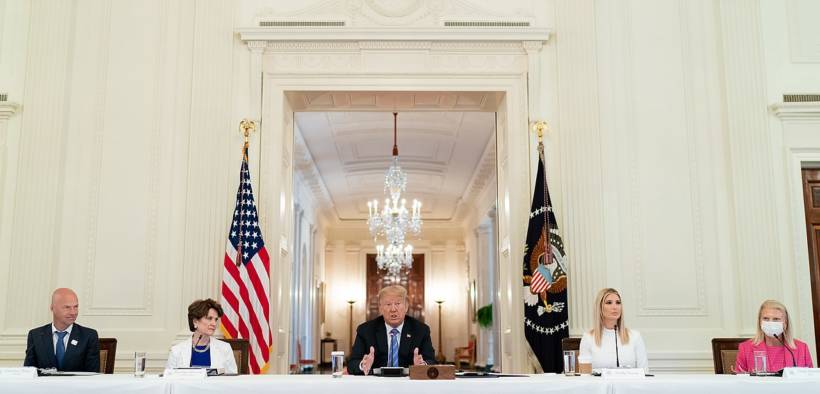What Have We Learned from COVID-19? (Spoiler Alert: Not a Whole Lot)


No one in their right mind would’ve wished for a deadly global pandemic like the one we’re experiencing now. The ultimate hope of many, meanwhile, is that we might learn something, anything about how to live our lives in a way that is better for us all and more sustainable given the uncertainty of the planet’s very viability owing to climate change.
Months into our communal COVID-19 response, however, it is difficult to see what has changed for the better exactly. Thus far, our inept or deliberately poor handling of this crisis has only served to lay bare the imperfections in our society and its underpinning systems, manifested in woeful inequality and callous indifference to the suffering of marginalized peoples. For all the masks we now don to combat the spread of coronavirus—and for some, that still is a work in progress—2020 has been, in many respects, a “mask-off” year. This, despite hundreds of thousands of deaths, economic disarray, and a complete upheaval of what is considered “normal.”
A recent New York Times report on disparities in the availability and quality of health care in New York City along socioeconomic lines is more or less a microcosm of the overall trend. The article, a joint production by Brian M. Rosenthal, Joseph Goldstein, Sharon Otterman, and Sheri Fink, details how outcomes have been markedly different for private facilities in Manhattan versus hospitals in poor neighborhoods.
Against a backdrop of disproportionate suffering for low-income neighborhoods, of which the majority impacted are blacks or members of the Latinx community and many of them immigrants or “essential” workers (so much for being truly essential), the piece, while acknowledging the myriad factors which affect how the infected recover or don’t recover, points to the potential significance of where someone is treated. Citing hospital mortality rates, the authors highlight how patients at community hospitals have been three times more likely to die from COVID-19 than their counterparts at private medical centers.
Mediating this gap are less access to drug trials, reduced staffing, and worse equipment, a function of underfunded public facilities. Meanwhile, private networks like New York-Presbyterian, NYU Langone, and the Mount Sinai Health System have better resources—monetary or otherwise—not to mention the support of government policies and a sizable revenue stream by way of Medicare and private insurance. Thus, while the top private networks rake in cash, the city’s public hospitals struggle to stay afloat financially and face closures. As you might expect, these facilities on the brink of ruin tend not to be located in Manhattan, but rather the Bronx, Brooklyn, and Queens.
Under normal circumstances, these contrasts in the affordability and availability of care are alarming and dangerous. In a pandemic marked by overcrowding of hospitals and bed shortages across regions? It’s a recipe for disaster. And while the authors of the Times piece give a 3-to-1 ratio overall for the disparity in patient outcomes (which, to be fair, is disputed by some respondents contacted by the authors within), depending on the location and other circumstances, it potentially could be wider. This reality is one the likes of New York state governor Andrew Cuomo and NYC mayor Bill de Blasio would be loath to lead with in their coronavirus press conferences.
In the early stages of America’s COVID-19 response, New York and New Jersey were hit particularly hard by the pandemic. These states have since seen declines, but now infection rates are rising in a majority of the U.S.’s 50, particularly in states like Florida and Texas which sought a hasty return to business as usual only to have to backtrack even faster. Even in states like NY and NJ that have largely weathered a first wave, fears of a second (and worse) wave spurred by outbreaks in other states have caused authorities to dial back movement into “Phase Two” of their reopening plans, even if in part. If the country has gotten coronavirus under control, someone sure forgot to tell the virus.
Indeed, America now stands at a potential tipping point with respect to its ability to do just that, with Health and Human Services Secretary Alex Azar suggesting that the “window is closing” for the United States to control COVID-19 outbreaks. That’s right—this is coming from a member of the Trump administration, an entity not known for having a solid relationship with the unvarnished truth. If someone like Secy. Azar is saying this, you know we’ve got a serious situation on our hands. Hell, even Donald Trump is extolling the virtues of masks of late. You know, despite not actually wearing one. Do as I say, not as I do. Not even a deadly pandemic will transform this guy.
The question is, though: Does America recognize this tipping point and is it ready to do what is necessary to avoid catastrophe? From the appearance of things, the answer would be a resounding no. Not when there yet is no national mask mandate in place. Not when lingering reports of “coronavirus parties” among teens and young adults exist. Not when umpteen videos of “Karens gone wild” can be found on social media where privileged women, predominantly white, are throwing a fit at the slightest hint of an inconvenience.
This pandemic is tough to handle, no matter who you are. If we can’t adhere to certain principles in trying to reduce the virus’s spread, however, and if we can’t keep our shit together when being told to wear a mask in Trader Joe’s (not for nothing, but is that really so much to ask?), how are we supposed to get through this without complete and utter devastation done to the nation? Four months into the COVID-19 response, we apparently haven’t learned a whole lot about how to handle it—and at this rate, we have a long, long way to go still.
If you’re reading this from outside the United States, first of all, welcome. I’m not sure how you found this post, but thank you for your time. To you, though, I pose this query: Do you believe I am writing this piece to try to engender sympathy for the U.S.A. or me? My love for my country notwithstanding, no, I’m really not. Because I get it. At this point, I’m not sure we deserve it. For all the times America has exported its brand of “democracy,” putting its interests ahead of the rest of the world’s and serving up diplomacy in the form of bombs and truncheons, we’re not a sympathetic figure in terms of foreign policy. We’re the New York Yankees of the world stage. If you’re not from here, to be honest, I don’t really know why you’d root for us.
Of course, unless you outright hate us, I don’t think you’re rooting for us to all die of coronavirus either. COVID-19 and its associated symptoms are something I wouldn’t wish on my worst enemy. Even if you don’t die as a result of infection, recovery might take weeks, and in many cases, there are lasting effects for the afflicted. While research is yet preliminary, patients may suffer from fatigue and damage to multiple organs as a result of contracting COVID. Simply put, you don’t want this disease, whether you’re 75 or 25. For this reason and more, say, holding a party and essentially playing a game of Russian roulette to see if you get infected is beyond stupid.
With the Fourth of July weekend upon us, I don’t wish to be a killjoy—you know, any more than I usually am. By pretty much every objective measure, though, America has been near the bottom if not the absolute worst at responding to the spread of coronavirus, especially when considering the nation’s capabilities and its advance warning from China and Europe. Furthermore, the virus does not care that it’s Independence Day. It has zero chill. It gives zero f**ks. This isn’t a game and it isn’t political. Wear a mask or other face covering if you’re around other people, practice social distancing when and where possible, wash your hands/use hand sanitizer, and strongly consider staying home if you can manage it.
It’s summer and, after months of fear, heartache, and uncertainty, we want to celebrate. Now is not the time to get reckless, however, and at heart, I wonder what it is we’re celebrating after all we’ve seen.







